Revised 18 January 2022
Accepted 25 November 2022
Available Online 10 January 2023
- DOI
- https://doi.org/10.55060/s.atssh.221230.036
- Keywords
- Low-rise housing
Rental houses
Rental development
Suburban and rural areas
Using historical heritage monuments
Volumetric and spatial solutions - Abstract
This article presents a survey of one of the types of housing, making it really affordable. Noteworthy, the main problem of using rental housing is the lack of shaping of its market. Tenement houses have a certain historical tradition in pre-revolutionary Russia and abroad. Basically, these were multi-story multi-room buildings of the corridor system. This article pays special attention to a new stage in the development of tenement houses, and on a completely unexpected basis: the urban population rushes to nature and rents low-rise housing in suburban and rural areas for recreational purposes. These people are interested in developing their own household territory, not rejecting from city apartments. The most valuable is the restoration of historical heritage monuments for rental purposes. According to the planning structure, low-rise rental houses are designed as two- or three-story detached houses, with a service block, and with an increased number of floors (up to four), with a corridor or gallery system and placement of service premises on the ground or upper floor. We come to the conclusion that the variety of rental houses will allow responding to changes in the demographic structure and needs of the population, to ensure the mobility of the workforce, and to satisfy the needs of young families.
- Copyright
- © 2022 The Authors. Published by Athena International Publishing B.V.
- Open Access
- This is an open access article distributed under the CC BY-NC 4.0 license (https://creativecommons.org/licenses/by-nc/4.0/).
1. INTRODUCTION
With an urgent need to provide the population of the state with housing and the lack of sufficient funds to purchase it, a non-standard step to solve the housing problem is in demand.
The situation remains difficult despite the implementation of the priority National Project “Affordable and Comfortable Housing for the Citizens of Russia”, in the frames of which the tasks of providing municipal or state housing, developing mortgage lending, and providing benefits to young families purchasing their own home, are being solved.
Let us consider the statistical materials of a large-scale study by the All-Russian Center for Studying the Public Opinion (VCIOM) [1]. 22.7 million of 61.7 million Russian families are in need of better housing conditions; 9.7 million of them are unable to realize it. Moreover, 55% of needy families with children or planning to have them cannot purchase a home. According to the survey, 9.4 million Russian families would like to take a mortgage, but it has become unaffordable, as many banks raised loans to 10%. The income of the population and housing market price levels do not allow 85% of citizens to purchase it.
Under these conditions, one of the ways to solve the housing problem is the use of rental housing. At the same time, it is necessary to solve a number of issues: to find out the number of those in need of rental housing and to adopt a number of legislative acts – introducing tax deductions from the income of landlords, regulating rent; and determining the mechanism for the allocation of land lots.
For the sake of cost-effective solutions in cities, multi-story multi-apartment rental buildings will prevail, but low-rise buildings can compete with them not only due to the simplicity of solutions (lack of elevators, light construction), but also due to the variety of types of buildings that take into account the needs of residents, the variety of planning decisions, as well as taking into account the emerging trend of city dwellers longing for ‘the nature’ with renting houses in suburban and rural areas.
For better understanding the problems and opportunities of low-rise rental housing, we may consider some examples of rental houses from domestic and foreign practice in historical terms.
2. DOMESTIC & GLOBAL EXPERIENCE IN THE FIELD OF CONSTRUCTION OF LOW-RISE RENTAL HOUSING IN HISTORICAL TERMS
The characteristic of the pre-revolutionary experience in the construction of tenement houses is given by academician of the RAASN L.V. Khikhlukha in his article ([2], pp. 2–8). Tenement dwellings appeared in Russia in the form of small private houses from the early 19th century. Their planning structure was gradually worked out, the number of floors increased. By the early 20th century, the most appropriate type of apartment building was a multi-story multi-section house, as well as such one with the corridor system. Such houses were widespread in St. Petersburg, where 85% of the population lived in them, about 70% of the population in Moscow and other cities.
But low-rise apartment buildings were also in demand, usually featuring a wide variety of solutions (Fig. 1 top). The house of Z.A. Pertseva, designed in a pseudo-Russian style, was built by architect N.K. Zhukov in 1883, rebuilt and decorated by artist S.V. Malyutin in 1905–1907; the house had an apartment system, there were artists' studios in the attic, also for rent. Today, the restored house accommodates the ‘Comedians’ Theatre, studios and clubs.
The house of S.D. Perlov (Fig. 1 bottom) was designed in the Chinese style by architect. R.I. Klein in 1890–1893, decorated by architect C.C. Gippius in 1895. There is a famous teashop on the ground floor, recently renovated and still working. Initially, the upper floors were rented out to wealthy citizens; now, they retained a residential function.
Of course, multi-section apartment buildings and hotel-type facilities for temporary residence prevailed in the pre-revolutionary rental housing fund, but low-rise apartment buildings have always stood out for their diversity and individuality.
Significant experience in the use of rental housing has been accumulated in many countries. The practice of planning the volume and structure of housing construction is based on census data and on the demographic composition of the family. Long-term global practice is distinguished by extensive research on the types of residential buildings. Two main types of hotel-type houses have become widespread: hostel houses and apartment buildings. In some cases, in hotel-type houses, along with apartments for small families and singles, apartments are provided for families with a large number of members (houses of a mixed or combined type). The corridor and tower type houses are also used ([2], pp. 6–7). It would be reasonable to use the best from the global experience.
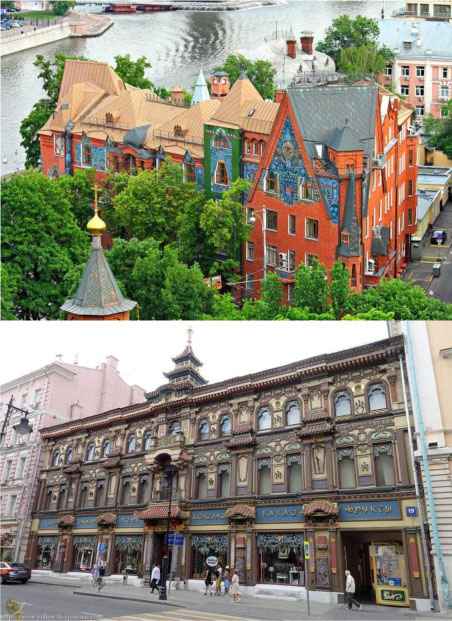
Low-rise tenement houses in pre-revolutionary Russia. Top: the house of Z.A. Pertseva at 1/1 Saimonovsky Pass in Moscow. Bottom: the house of S.D. Perlov with a teashop at 19 Myasnitskaya Street, Moscow.
3. CONTEMPORARY CONSTRUCTION OF LOW-RISE RENTAL HOUSES
An important factor in the foundation of architectural typology of rental dwelling is with low-rise building [3]. Such houses are built in cities, in the form of separate mansions or higher buildings (up to four floors) of the corridor or sectional system, but they are much more widespread and diverse in suburban and rural areas. In suburbs, the most serious obstacle is the lack of social infrastructure. In rural areas this issue is easier to solve: tenants use the village services. As a rule, houses are located in a group.
In the village of Obukhovo, Tver Region, one- or two-story houses can be rented for a long time, for a summer or a day (Fig. 2). The complex was built in 2007–2009. The authors are architects Yu.P. Zaitseva, N.V. Bykova, D.K. Teterina, D.Yu. Perov. In addition to residential houses, the complex has a recreational function due to the entertainment center.
A rental complex of seven three- and four-roomed houses was built according to a project of the 1990s in the cottage settlement of the ‘Belaya Dacha’ Agrarian Firm, Moscow Region (Fig. 3). The authors are architects V.S. Anikin and I.G. Privezentsev. The master plan shows that the complex includes two two-apartment and three single-apartment houses framing the courtyard, the complex includes a service block with a dispatch service, an order bureau, a hall for events, a sauna, and a garage for seven cars in the basement [4].
A new trend in the practice of low-rise rental building is the construction of mansions for family holidays in the complexes of health-improving institutions. An example is the creation of a group of two-story mansions for big families with children on the territory of the Valuevo Sanatorium in the Moscow Region (Fig. 4). Head of the authors’ team is M.G. Leizerovich, architects: V.S. Anikin, G.A. Brzhozovsky, V.I. Kolpikov, I.V. Gutnik, I.V. Rutman, L.I. Sergeeva.
The picturesque location of single-family two-story houses with different quantities of rooms and living standards, various spatial structures, and individual outlook ensures the choice of a mansion depending on the family size, its demands on living standards, and investment opportunities.
For several years, a study of tenement houses in the segment of low-rise housing has been carried out by specialists from the Republic of Tatarstan I.F. Gareev and E.V. Bryukhanova [5]. They conducted an analysis of the supply and investment attractiveness of low-rise rental houses in cities and suburban areas with a picturesque landscape and found that supply exceeded demand. The authors of the study believe that now the tenant's market, since it determines the variants of transactions, carefully selects from a large number of objects and actually dictates the price.
In the city, people prefer to rent comfortable individual houses; in suburban areas the situation is different: according to the example of the Laishevsky District, entire fishing villages are built of wood on the banks of the reservoir, and houses are built both for families, and for a whole company up to 15 people. The structure of the premises and the general area of such houses vary.
The authors' study is reliable because they used statistical analysis and field observations.
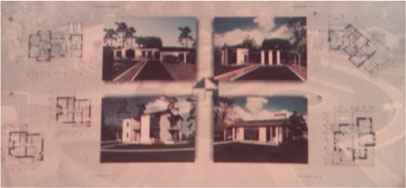
Hotel-residential complex in Obukhovo village.
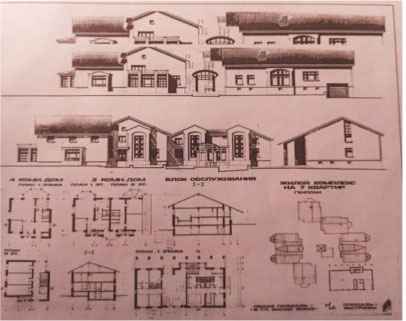
Rental complex in the cottage settlement of the ‘Belaya Dacha’ Agrarian Firm in the Moscow Region.
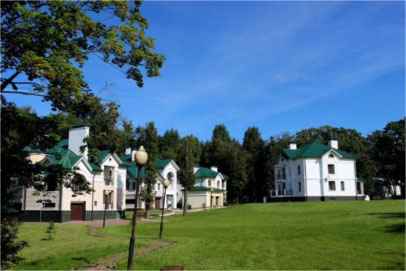
Mansions for big families with children in the Valuevo Sanatorium in the Moscow Region.
4. RESTORATION OF HISTORICAL MONUMENTS FOR RENTAL PURPOSES
Monuments of cultural and historical value are preserved in rural and suburban areas. This may be a building of spiritual significance, an old manor, industrial buildings, or even a horse yard. Many of them are restored and rented out, mainly for recreational purposes.
The village of Vyatskoye, Yaroslavl Region, is multifunctional: it is dominated by rural residents who have manor houses and grow early vegetables and fruits; besides, the village acquired trade and craft functions and is known for its fairs and master classes reviving folk crafts. In 2007, the reconstruction of Vyatskoye was started with a purpose to turn it into a tourist center: in addition to the Church of the Resurrection of Christ, a street of two-story rental houses with full board was restored in it, and ten museums were built to represent typical Russian life: Museum of the Trading Peasant, Exhibition of Russian entrepreneurship, Russian ‘black bath’, etc. A two-story hotel and a restaurant were built on the main street of the village.
An interesting experience in the restoration of historical heritage monuments for rental purposes can be noted in the Skornyakovo-Arkhangelskoye Estate in the Lipetsk Region (Fig. 5). The estate has existed since 1680. It was owned by worthy people who, beside building for their own needs, were engaged in social activities. In addition to housing, a factory, a school, and a horse yard were built. In 1918, the estate was nationalized, but all the buildings were used for the needs of the ‘Tihiy Don’ State Farm.
The restoration of the estate complex was started in 2008 with the St. Archangel Michael Church; by now the white-stone buildings have been restored: the ‘House with mezzanine’ for rented apartments, the factory as a restaurant, the horse yard as a hotel and a gallery. It is to become a spiritual and museum center.
Using historical monuments for rental purposes is a way to create an investment and innovation incentive.
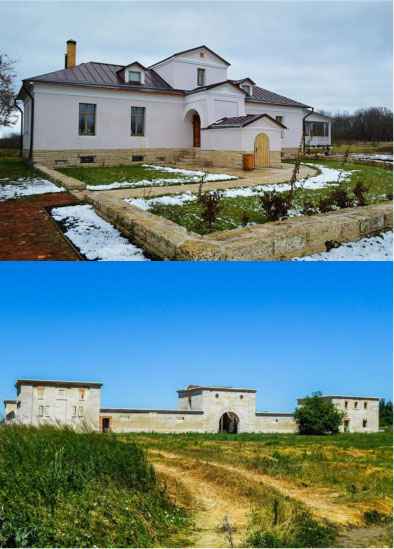
Rental houses in the Skornyakovo-Arkhangelskoye Estate in the Lipetsk Region. Top: “house with mezzanine” with apartments for rent. Bottom: horse yard with a hotel and a gallery.
5. PLANNING STRUCTURE OF LOW-RISE RENTAL HOUSES
The planning structure of a rental house depends on the chosen type of rental dwelling and can be as diverse as the types of houses. But there is one general principle aimed at cost-effectiveness and, consequently, the competitiveness of the house: this is a desire to reduce walk-through areas, hallways, reduce kitchens, combine sanitary devices, and combine household processes.
A promising solution for the layout of a rental dwelling is associated with the flexibility of the space-planning structure. Low-rise rental buildings are most often apartment or hotel structures. The planning structure of an apartment, depending on the proportion between residential and utility rooms, can be reduced to two main methods:
Layout with a separate common room, with an entrance from the front or corridor;
Layout with a walk-through common room serving as a node for intra-apartment communications.
The blocked-type apartment buildings have great spatial possibilities. They can be linear, cruciform, or petal structure. In the Netherlands, in the town of Lemmer, houses for recreation on the water were built in the form of semicircles, one house was designed in the form of an ‘eight’, it provides rooms for pets, which is important, since it is usually difficult to find a place for your pet [6,7].
A compact block house with a cruciform structure was built in Hamburg (Fig. 6). According to the plan, each apartment is connected to the site. Inside the house, furniture and equipment divide the space into zones [8]. For small families and singles, as a rule, the hotel-type rental houses are built; they are characterized with the corridor system with a one-way orientation or the gallery system in regions with a soft climate [8].
In low-rise rental buildings, additional living space should be provided by verandas, terraces, and attics.
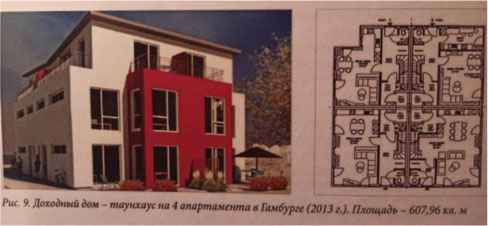
Tenement townhouse with four apartments in Hamburg (2013). Area: 607.96 m2.
6. CONCLUSION
Summarizing the material, it can be noted that:
Rental housing on the market will be the form that allow you to respond flexibly to changes in the demographic structure, ensure the mobility of the labor force, and satisfy the needs of young families and migrants [8];
The use of low-rise apartment buildings will allow you to solve quickly certain production and recreational problems in suburban and rural areas in terms of providing housing for different periods;
A variety of low-rise apartment buildings will bring individuality to the appearance of settlements;
The key task for development of the rental housing market is the legalization and transparency of the existing spontaneous housing market.
AUTHOR'S CONTRIBUTION
This article was independently completed by Svetlana Moiseeva. The author made field measurements of houses in the settlements of the Kaluga, Moscow, Tver, and Yaroslavl Regions.
ACKNOWLEDGMENTS
This study is based on research supported by the Program of Fundamental Research of the Russian Academy of Architecture and Construction Sciences and of the Ministry of Construction, Housing and Utilities of the Russian Federation, 2022, topic 1.1.6.2.
Under the supervision of academician of the RAASN L.V. Khikhlukha and in cooperation with him, the author worked out the recommendations in “Fundamentals of the Architectural Typology of Rental Residential Buildings” [8], approved and put into effect by the Decree of the Presidium of the RAASN, No. 5, dated 26 April 2021.
REFERENCES
Cite This Article

TY - CONF AU - Svetlana B. Moiseeva PY - 2023 DA - 2023/01/10 TI - Problems and Possibilities of Low-Rise Residential Housing of the Rental Type BT - Proceedings of the 4th International Conference on Architecture: Heritage, Traditions and Innovations (AHTI 2022) PB - Athena Publishing SP - 271 EP - 275 SN - 2949-8937 UR - https://doi.org/10.55060/s.atssh.221230.036 DO - https://doi.org/10.55060/s.atssh.221230.036 ID - Moiseeva2023 ER -









